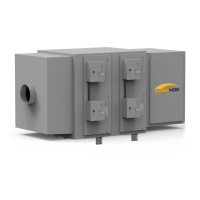14
6.6 Rinse Procedure
Cleaned components should be rinsed off quickly and thoroughly
to remove remaining contaminants. If the components appear
to be clean, some detergent residue may remain. This should
be removed because the residue may contribute to voltage
bleed-down when the unicell is placed in operation. Also, even
though the detergent is “buffered” prolonged contact could cause
oxidation. As with cleaning, hot water should be used for rinsing.
6.7 Dry-Out Time
Unicells and filter media should be dry before the PSG is placed
into operation. Startup of a wet system will cause dead short
conditions to the ionizer and collector cell circuits. Wet unicells
and filter media should be placed in a warm room for drying.
Techniques such as hand wiping insulators and blowing dry
unicells and filter media with compressed air will decrease
drying time. Another method for drying cleaned components is
installing the unicells and filter media in the PSG and placing on
the system blower on line, with all power pack enclosure toggle
switches placed in the “off” position for 30 minutes.
7. Manual Cleaning Methods
The manual cleaning method selected will depend on the type of
contaminant, rate of deposit, facility limitations such as cleaning
time windows (process downtime) and available utilities. All cleaning
methods listed in this section are acceptable.
7.1 Soak Tank
This is the most effective method which involves placing
unicells and filter media in an agitated solution of hot water and
detergent. With proper detergent selection and concentration,
this procedure will quickly remove most contaminants. Unicells
and filter media should not be placed in highly concentrated
detergent solutions or allowed to soak for extended periods,
(e.g., overnight), especially at elevated temperatures. Extended
period of soaking in solvent or detergent solution will degrade
components (oxidation) over time and should be avoided.
7.2 Portable Pressure Washer
A self-contained pressure washer with a spray wand can be
an effective cleaning method, providing it is used with caution.
Care should be taken not to expose the unicells to close-up and
prolonged blasts of high pressure/temperature, causing cell
plate deformity, requiring a replacement set of unicells and filter
media.
7.3 Automatic Parts Washers
Certain commercially available units which are effective combine
and automate the features necessary for effective cleaning,
including water heating, detergent injection, agitation, rinsing
and drying.
7.4 Other Cleaning Considerations
The previous methods address the cleaning of unicells and filter
media. The PSG cabinet should also be periodically cleaned
(i.e., during normal planned downtimes) to reduce contaminant
build up. High voltage output of the power packs should also be
checked when manual cleaning is performed.
8. Appearance Of Components
After Cleaning
Components should have a clean, not necessarily “new,” aluminum
appearance. Discoloration will not affect system efficiency. The
following are acceptable conditions for the system components.
Parts should be replaced as required.
8.1 Unicell
1. Frame, end plates and cell plates are free of contaminant
build-up (residual contaminant has been removed between cell
plates, and ionizer wire support bars).
2. The frame is square, cell plates are parallel, cell hot plates (small
dimensional plates) are centered between ground plates (large
dimensional plates).
3. Ionizer standoff insulators and cell triangular insulators (front
and rear) are cleaned (no residual coating). Cracked or carbon-
tracked insulators have been replaced.
4. Ionizing wires and springs are intact and taut, centered between
ground plates with no contaminant build up or coating.
5. Contact springs and contact screws are properly located and
not deformed replace missing or deformed contact hardware.
6. Bent or broken parts have been repaired or replaced.
8.2 Prefilters/Afterfilters
1. Aluminum media and frame are free of contaminant.
2. Frame is square and media is intact.
3. Filters are always installed with drain holes down and arrow on
each frame pointing in the direction of airflow.
8.3 Cabinet
1. Door feed-thru insulators are cleaned and white.
2. Door gaskets are cleaned and intact.
3. Component tracks are free of contaminant build up (for unicell
grounding).
4. Module drain sumps are cleaned and free-flowing.
5. Interior is free of extreme contaminant build-up.
6. Blower wheel and housing is free of extreme contaminant build-up.
7. Preconditioning equipment (inlet plenum with baffle filters,
cooling coils, etc.) has been checked for excessive pressure
drop, cleaned if necessary.
8. Nozzles on all in-place cleaning system headers are not plugged.

